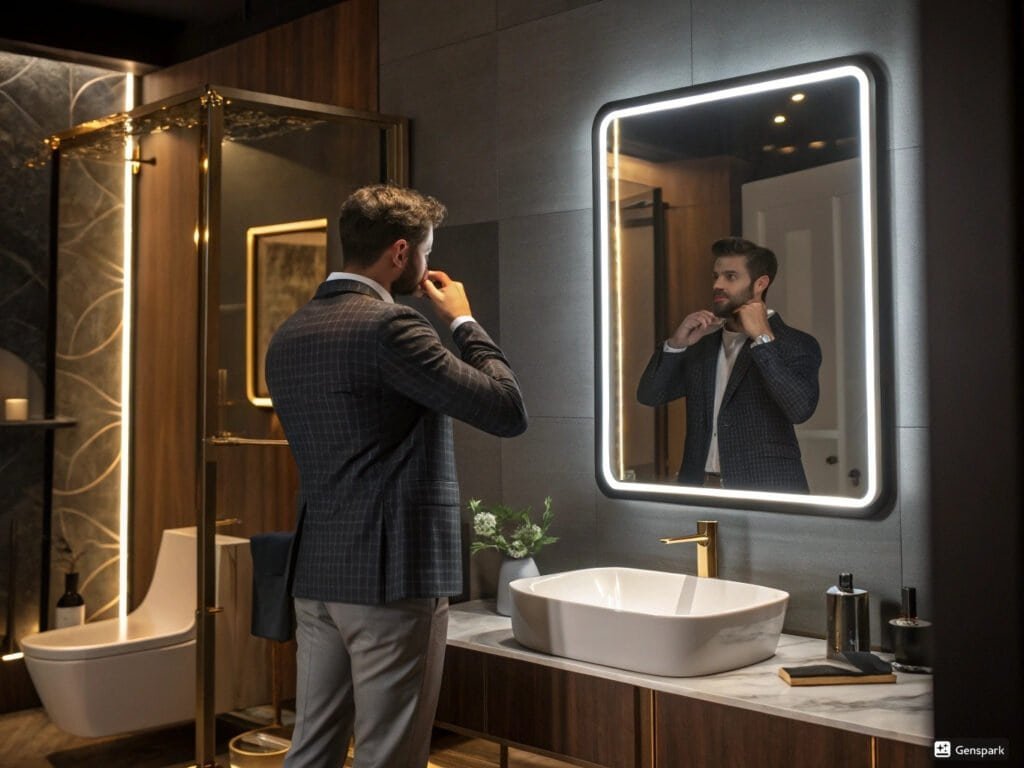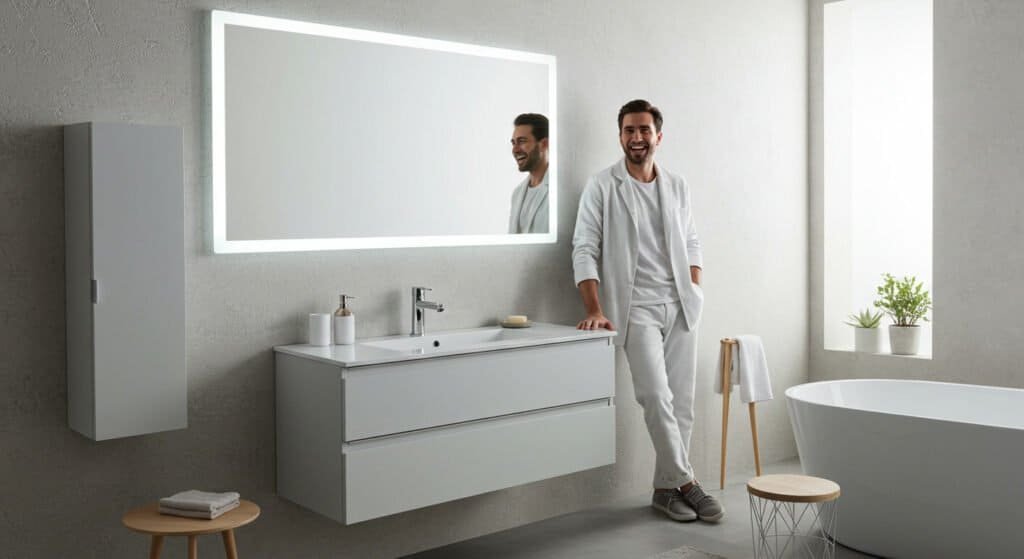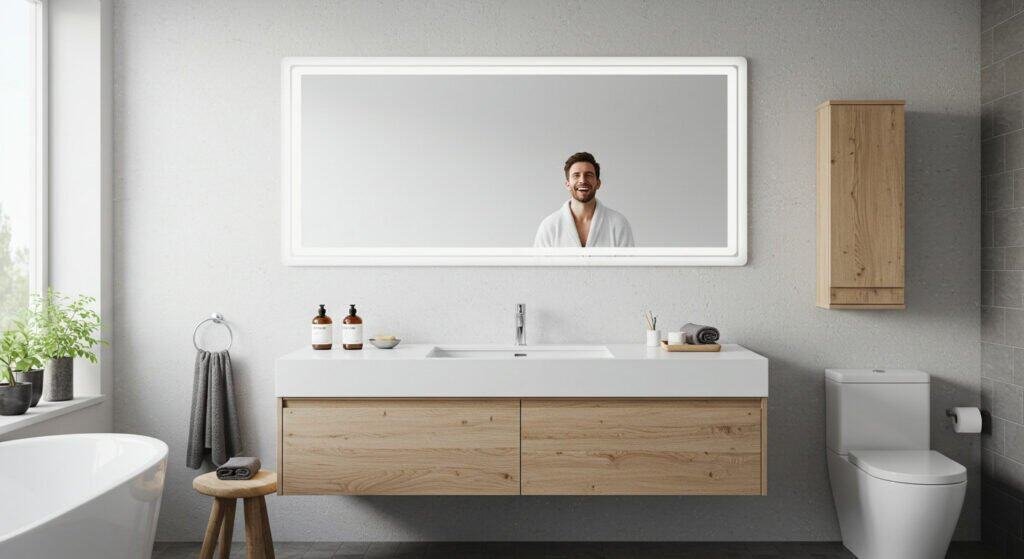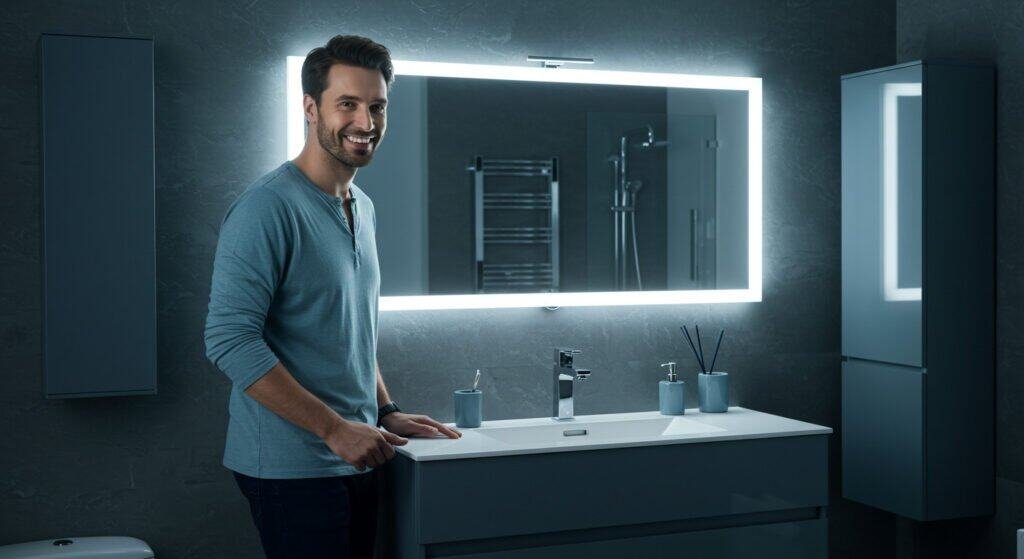Do LED Mirrors Need To Be Plugged In? Yet many homeowners hesitate, wondering about electrical requirements and installation complexities before making this investment.
Most LED mirrors require a power connection for optimal performance, though battery-powered options exist for specific situations. Traditional wall-mounted LED bathroom mirrors typically need hardwiring or plugging into nearby outlets, while portable lighted makeup mirrors often offer rechargeable or battery-operated alternatives.
Let’s explore the various power options for LED mirrors to help you make an informed decision for your specific needs.

How Do LED Mirrors Work?
LED mirrors combine traditional glass mirrors with integrated light-emitting diode technology, creating functional illumination around or behind the reflective surface.
LED mirrors work by incorporating energy-efficient diodes around the perimeter or behind the glass, providing even, shadow-free lighting that mimics natural daylight for accurate reflections.
The beauty of LED mirrors is their elegant yet basic design. Unlike traditional bathroom vanity mirrors, which rely on separate light fixtures, LED bathroom mirrors incorporate lights directly into the mirror itself. The lights can be placed along the edges (edge-lit), around the perimeter (front-lit), or behind the mirror (backlit mirror) to generate various lighting effects.
Modern LED mirrors frequently have extra functions such as touch sensors, dimmers, and color temperature adjustments, allowing users to tailor their illumination experience to different activities—from applying makeup to shaving or simply checking their appearance.
How Are LED Mirrors Powered?
LED mirrors require electrical power to illuminate their integrated lighting systems, with several connection options available depending on the mirror design.
Most bathroom LED mirrors are powered through direct electrical connections to your home’s wiring system or by plugging into standard wall outlets, though portable options may use batteries or rechargeable power banks.
When examining the power requirements of your LED light mirror vanity, it’s important to understand the distinction between hardwired and plug-in options. Hardwired mirrors connect directly to your home’s electrical system, creating a cleaner appearance without visible cords but requiring professional installation.
Plug-in LED bathroom mirrors are easier to install because they use a regular power cord to connect to a nearby outlet, making them more adaptable to various bathroom layouts. LED mirrors consume significantly less electricity than standard lit vanity mirrors for bathrooms, ranging from 20 ل 60 watts depending on size and features. This efficiency translates to cheaper energy bills while still offering improved illumination—a wealth-building approach that Robert Kiyosaki would appreciate: investing in assets that add value while decreasing continuing costs.

Do LED Mirrors Work With a Battery?
Yes, certain LED mirrors can operate on batteries, particularly portable lighted makeup mirrors and smaller wireless makeup mirrors designed for tabletop use, providing convenient illumination anywhere.
The field of battery powered vanity mirrors has grown dramatically in recent years, providing independence from fixed power sources—much like financial independence comes from breaking free from established income streams. Rechargeable vanity mirrors are the most convenient alternative, as they include built-in lithium-ion batteries that can be charged via USB cords.
These typically offer 2-8 hours of continuous illumination, depending on brightness settings and battery capacity. Traditional battery operated mirror wall mounted options use replaceable batteries (often AA or AAA), providing a truly wireless solution for spaces lacking electrical outlets.
The trade-off with battery power mirrors is limited brightness and continual battery replacement costs, analogous to how passive income takes an initial investment but provides long-term independence. Plug-in or hardwired bathroom vanity mirrors give more consistent performance and brightness in primary bathrooms than battery-powered options.
Do LED Mirrors Provide Enough Light?
The lighting capability of LED mirrors is a crucial consideration for bathroom functionality and aesthetic appeal.
Modern LED bathroom mirrors typically provide ample illumination for most bathroom activities, with premium models offering adjustable brightness levels and color temperature settings to suit different needs throughout the day.
The trade-off with battery power mirrors is limited brightness and continual battery replacement costs, analogous to how passive income takes an initial investment but provides long-term independence. Plug-in or hardwired bathroom vanity mirrors give more consistent performance and brightness in primary bathrooms than battery-powered options.
Most LED bathroom mirrors deliver between 3000-6000 lumens depending on size and design, comparable to traditional bathroom lighting fixtures but with better distribution and less glare. The color rendering index (CRI) of premium LED mirrors typically exceeds 90, ensuring accurate color representation—crucial for makeup application and skin assessment.
Models with adjustable color temperatures allow users to vary between warm (2700K-3000K) for relaxed surroundings and cooler (4000K-5000K) for task-oriented illumination. When determining whether a given LED mirror will provide adequate lighting, examine the mirror’s size in relation to your bathroom, the surrounding wall color (darker walls absorb more light), and complementing lighting in the room.

Do Smart Mirrors Have to Be Plugged In?
Smart bathroom mirrors represent the cutting edge of bathroom technology, offering advanced features beyond simple illumination.
All bathroom smart mirrors require consistent power connections to operate their integrated technologies, with most models designed for hardwiring or plug-in installation rather than battery operation.
Smart mirrors exemplify the premise of using technology to produce assets that increase in value over time, which financial experts repeatedly underline. These modern devices include integrated touch screens, Bluetooth speakers for music streaming, digital clocks and temperature displays, motion sensors for automated activation, and even voice assistant support.
The power requirements for these advanced features make battery operation impractical for daily use, as the energy demands would rapidly deplete even large-capacity batteries. Instead, manufacturers design these mirrors with stable power connections in mind, either through direct hardwiring to your home’s electrical system or via standard electrical outlets.
When selecting a bathroom smart mirror, consider not just the upfront cost but also the long-term utility—how the additional features will enhance your daily routine and potentially increase your home’s value, similar to how strategic investments compound benefits over time.
Energy Efficiency and Power Consumption
Understanding the energy profile of LED mirrors helps consumers make economically and environmentally sound purchasing decisions.
LED mirrors consume significantly less electricity than traditional backlit mirrors or separate vanity lighting, with most models drawing between 20-60 watts depending on size and features activated.
The energy efficiency of LED mirrors exemplifies the “work smarter, not harder” principle that successful wealth-builders advocate. Compared to traditional incandescent vanity lighting that might consume 300+ watts, LED bathroom mirrors typically use 75-80% less electricity while providing superior illumination quality.
This efficiency translates into considerable utility bill savings—between $10 ل $30 per mirror every year, depending on consumption habits and local electricity tariffs. Most wall mirror with lights models include energy-saving features such as automated shut-off timers, motion sensors, or memory functions that recall preferred settings in order to further reduce power consumption.
Lower energy consumption results in a reduced carbon footprint, which is important as resource stewardship becomes increasingly significant. When considering long-term ownership costs, take into account not just the purchase price, but also the operational savings throughout the 15+ year lifespan of quality LED mirrors—another parallel to investment thinking in which total return is more significant than initial cost.

Are LED Mirrors Wired In?
The installation method for LED mirrors varies based on design, with many premium models requiring electrical connections.
Most full-sized LED bathroom mirrors are designed to be wired in for consistent power and performance, though manufacturers increasingly offer plug-in versions for flexible installation options.
When comparing wiring options for lighted vanity mirrors for bathroom installation, hardwired connections represent the more permanent, elegant solution—similar to how long-term investments often yield superior results to quick fixes. The hardwiring process involves connecting your LED mirror directly to your bathroom’s electrical circuit, typically requiring a junction box behind the installation location.
This creates a seamless look without visible cords, but necessitates cutting into walls and working with electrical wiring—tasks best handled by qualified electricians. Alternatively, plug-in LED bathroom mirrors offer the convenience of simply connecting to existing outlets, allowing for easier installation and potential relocation in the future.
The decision between hardwired and plug-in options often depends on your bathroom’s specific layout, existing electrical infrastructure, and whether you’re seeking a permanent installation or maintaining flexibility. As with financial decisions, the best choice depends on your long-term vision and willingness to make upfront investments for future benefits.
How to Install LED Mirror
Installing an LED mirror requires careful planning and adherence to safety protocols, particularly when dealing with electrical components in bathroom environments.
Proper LED mirror installation involves selecting an appropriate location, securing electrical connections according to local building codes, and mounting the mirror securely while protecting both the mirror and electrical components from moisture.
The installation process varies significantly between different types of bathroom vanity mirrors. For plug-in LED bathroom mirrors, installation is relatively straightforward: mount the mirror brackets according to manufacturer specifications, hang the mirror, and connect the power cord to a nearby GFCI-protected outlet.
Hardwired LED light mirror vanity installation is more complicated, as you must first switch off the power at the circuit breaker, connect the mirror’s wiring to your bathroom’s electrical supply using proper wire connectors, and secure all connections in a junction box. Battery-operated mirror wall mounted choices are the simplest to install, requiring simply secure mounting hardware and no electrical considerations.
Regardless of mirror type, installation should maintain proper clearance from water sources and follow manufacturer guidelines for moisture protection. Like building wealth, proper mirror installation requires attention to detail and following established principles—cutting corners may create short-term convenience but long-term problems.

Pros and Cons of Lighted Mirrors
Weighing the advantages and disadvantages of LED mirrors helps determine if they’re the right investment for your bathroom renovation.
Lighted mirrors offer superior illumination, modern aesthetics, and space-saving convenience by integrating lighting into the mirror itself, though they require electrical considerations and represent a higher initial investment than standard glass mirrors.
The pros of LED bathroom mirrors extend beyond mere functionality. Like diversified investment portfolios, these mirrors serve multiple purposes: providing excellent task lighting for grooming, creating ambient illumination for the entire bathroom, and serving as statement design pieces that elevate the room’s appearance.
Additional advantages include energy efficiency (consuming 80% less electricity than traditional incandescent vanity lighting), exceptional longevity (50,000+ hours of operation), and special features like anti-fog heating elements and touch-sensitive controls. The primary drawbacks involve the higher initial price point compared to standard glass mirrors and separate lighting fixtures, potential repair complications when components fail, and installation requirements that may necessitate professional assistance.
Battery operated vanity mirrors address some installation concerns but introduce battery replacement and charging considerations. As with financial decisions, determining whether an LED mirror represents a wise investment depends on your personal priorities, long-term plans for the space, and budget constraints.
Advanced Features Requiring Power in LED Mirrors
Modern LED mirrors offer sophisticated functions beyond basic illumination, each requiring reliable power sources.
Today’s advanced LED bathroom mirrors incorporate features like defoggers, Bluetooth audio systems, digital clocks, magnification panels, and motion sensors—all requiring consistent electrical power to function properly.
The evolution of bathroom mirror technology parallels the financial principle of creating multiple income streams—each feature adds additional value and functionality to the core product. Anti-fog technology uses heating elements within the mirror to prevent condensation during hot showers, requiring 15-25 watts of additional power.
Integrated Bluetooth speakers transform your silhouette LED vanity mirror into an entertainment center, though they increase power consumption and complexity. Magnification panels with dedicated lighting help with detailed grooming tasks, while integrated clocks, temperature displays, and even TV screens in premium models add convenience but demand stable power connections.
Motion sensors that automatically turn on lighting when someone approaches are both a luxury feature and an energy-saving method. Understanding these power-dependent features enables consumers to make informed decisions about which benefits are worth the added complexity and cost—just as clever investors carefully consider possible returns before allocating money.

خاتمة
Choosing the right LED mirror involves balancing power requirements with your specific needs and bathroom configuration. While most LED mirrors do require electrical connections, options exist for every situation.
Consider your priorities—installation simplicity, feature set, portability—when deciding between hardwired, plug-in, or battery-operated LED mirror options for your bathroom transformation.



